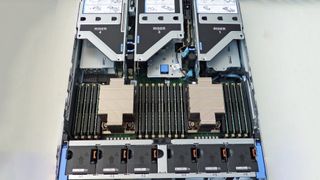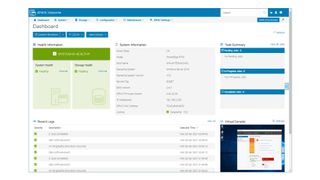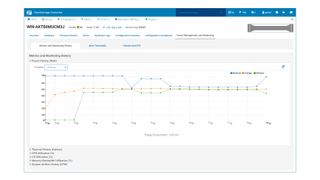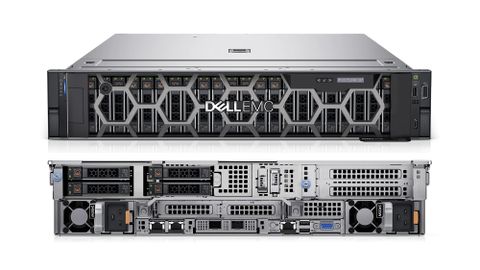IT Pro Verdict
Pros
- +
Gen3 Xeon Scalable CPUs
- +
Massive memory capacity
- +
Smart internal design
- +
High PCI-E 4 expansion potential
- +
NVMe hardware RAID support
- +
Great server and power management tools
Cons
- -
Nothing of any significance
The server market has seen some big changes recently. but Dell EMC looks set to shake it up even further with the largest product launch in its history. The 15th-generation PowerEdge family comprises 17 new and refreshed models and in this hands-on review, we look at the latest version of its trusty 2U data centre workhorse.
As expected, the PowerEdge R750 supports Intel’s 3rd Generation ‘Ice Lake’ Xeon Scalable CPUs which finally give AMD’s well-established EPYC chips some serious competition. Employing a 10nm architecture, they range from 8 to 40 cores and up to 64 PCI-E 4 lanes per socket, support DDR4 memory speeds up to 3,200MHz and claim an average 46% performance improvement over the previous generation for common data centre workloads.
Three versions of the R750 are available, but we’re focusing on the standard general-purpose model. The R750xa is built for GPU-based workloads and claims the highest density of GPUs in a 2U rack server while the R750xs is a cost-optimized version aimed at specific customer workloads.
The R750 presents a radical redesign over the R740 with a sharper focus on internal cooling. Storage capacities stay the same, with a maximum of 28 SFF bays available, but NVMe SSDs get some serious attention and expansion potential receives a massive boost.
Dell EMC PowerEdge R750 review: Internal layout
Internally, the R750 has a similar layout to the AMD-based PowerEdge R7525 as its T-shaped motherboard allows the PSUs to be placed on each side of the chassis. This improves air flow through the chassis so there are no hot spots and on the 1U R650 model, it creates extra exhaust lanes to help cool the CPUs.

Dell EMC’s multi-vector cooling creates streamlined pathways so air can be directed where it’s needed most using automation or user-defined profiles. These features aim to reduce the need for expensive liquid-cooling but in rack dense environments where heat dissipation is a major requirement, you can specify direct liquid cooling (DLC) kits that feature proprietary leak detection systems and shutdown services.
A bank of six hot-plug cooling fans are arranged in front of the motherboard and our server came with the Silver series modules. If you want the core-dense, high TDP Xeon Scalable Platinum 8300 CPUs, you’ll need to specify the higher performing Gold fans.
General internal design is very tidy with the two 28-core 2GHz Xeon Scalable Gold 6330 CPUs in our system laid out neatly across the chassis, mounted with solid passive heatsinks and flanked by 16 DIMM slots per socket. The price of our server includes 1TB of DDR4 RDIMM currently upgradeable to 2TB, while the maximum 8TB can be achieved with a full house of 256GB LRDIMMs or sixteen of Intel’s latest Optane 200 persistent memory modules.
Dell EMC PowerEdge R750 review: Storage features
The R750 offers an extensive range of storage options that start with a 12-bay LFF hot-swap backplane for SAS3/SATA devices. We have the model with the 16-bay SAS/SATA SFF backplane and Dell EMC provided eight 2.4TB SAS3 SFF HDDs which we’ve included in the price shown.
For NVMe SSDs, you have a number of options as in our system, there’s room to the right for an extra 8-bay backplane. You can go for a full house of NVMe SSDs with a 24-bay backplane but this doesn’t support SAS/SATA devices. It’ll cost you a PCI-E riser but you can add a 2-bay or 4-bay enclosure at the back and choose from SAS/SATA or NVMe SSD versions.

RAID sees big improvements as the new PERC11 controllers have been moved on to dedicated slots on the storage backplane. We have the standard PERC H755 front SAS model and the PERC H755N model finally brings hardware RAID to NVMe devices as this PCI-E 4 adapter has the bandwidth to make this a reality.
The BOSS (boot optimized storage solution) card gets a big makeover as well. Instead of being buried inside the server, the new S2 version presents its two M.2 slots at the rear where SATA SSDs are fitted in removable hot-swap carriers.
Dell EMC PowerEdge R750 review: Expansion and management
Expansion potential is outstanding as the revamped internal design provides sufficient room for four dual-slot PCI-E 4 risers. A range of risers are available and include a Snap I/O version that currently supports Infiniband adapters and allows them to have a x8 connection to each CPU for reduced latency.
What’s more, underneath the central riser is an OCP 3.0 mezzanine edge slot. This replaces the older proprietary LOM surface port so the R750 can use open-standard network cards from other partners as well as Dell’s own offerings.
The iDRAC9 controller doesn’t see any major improvements but none are needed - it already provides the best remote management features in town. Its web console presents a ton of information on server operations plus hardware health, with the Datacenter license adding advanced services such as streaming telemetry for predictive analytics.
We run Dell EMC’s OpenManage Enterprise (OME) server in the lab as a Hyper-V VM allowing us to monitor and configure all our PowerEdge servers from one web console. To test the Power Manager plug-in, we imported an iDRAC9 Enterprise Advanced license to the R750, added it to our monitored device group and used the OME home page to view historical graphs of group power consumption ranging from 6 hours to a year, check on thermals and see which systems were using the most power.

The plug-in will prove invaluable to data centres as it supports up to 8,000 systems and can enforce per-rack power cap and thermal event-based policies to automatically throttle servers back when they’re getting toasty. And if the situation becomes critical, the EPR (emergency power reduction) feature can push out an instant mass policy to selected groups forcing all members to drop to a low power mode or be gracefully shut down.
Dell EMC PowerEdge R750 review: Verdict
As one of the first Gen3 Xeon Scalable servers to market, the PowerEdge R750 sets a very high standard for the rest to follow. The redesigned chassis delivers improved cooling, a huge expansion potential plus plenty of great storage features, and combining these with top-notch remote management services makes this 2U rack server ideally suited to a wide range of common data centre duties.
Dell EMC PowerEdge R750 specifications (as reviewed)
| Chassis | 2U rack |
| CPU | 2 x 28-core 2GHz Intel Xeon Scalable Gold 6330 |
| Memory | 1TB 2,933MHz RDIMM DDR4 ECC (max 8TB with LRDIMM) |
| Storage bays | 16 x SAS/SATA SFF (max 28) |
| RAID | Dell PERC H755 front SAS |
| Storage included | 8 x 2.4TB 10K SAS3 SFF HDDs |
| Other Storage | Dell BOSS-S2 with 2 x 480GB M.2 SATA SSDs |
| Network | 2 x Gigabit |
| Expansion | 8 x PCI-E 4 slots, 1 x OCP 3.0 slot |
| Power | 2 x 1,400W Platinum hot-plug PSUs |
| Management | Dell iDRAC9 Datacenter |
| Warranty | 3Yr Standard On-Site NBD |
Dave is an IT consultant and freelance journalist specialising in hands-on reviews of computer networking products covering all market sectors from small businesses to enterprises. Founder of Binary Testing Ltd – the UK’s premier independent network testing laboratory - Dave has over 45 years of experience in the IT industry.
Dave has produced many thousands of in-depth business networking product reviews from his lab which have been reproduced globally. Writing for ITPro and its sister title, PC Pro, he covers all areas of business IT infrastructure, including servers, storage, network security, data protection, cloud, infrastructure and services.



